An unwilling patron of the arts for over three decades, Subodh Kerkar talks about democratising art for the public sphere and his own personal evolution as an artist, in a telephonic interview with Sonalee Tomar.
Art needs to be democratised. Art has many functions, and one of the biggest roles it plays is to break the dichotomies of things and create a plural and tolerant society.
Subodh Kerkar
Featured image: Portrait courtesy Subodh Kerkar.
In a witty, eye-opening talk, artist Subodh Kerkar takes us on a a riveting inter-continental journey, that demystifies the origins of our so-called ‘traditional Indian foods’ via the history of globalisation.
Let’s start at the beginning of your tryst with art. Tell us about some pivotal moments.
I’m someone who is marinated or pickled in art. I gave up my medical profession 30 years ago – I used to run a hospital. And it wasn’t an instant jump; it took me some time to understand what it was all about.
My father was a realistic painter and a schoolteacher in Goa, and my only exposure was traditional mediums. So when I started, the only thing I knew was professional watercolours, I had become adept with the medium at an early age. And then it took me many years to break through the walls and I’m continuing to break them till today.
One of the pivotal moments was this major realisation; that in a country of over a billion-and-a-half people, not even one percent understands or connects with contemporary art. And by people, I mean the doctors, engineers, professors, architects and designers; the people who form the informed class, so to speak.
I was recently invited to inaugurate IIID conference of architects and designers in Goa, and in my opening speech, I listed the names of the top 10 contemporary Indian artists, and asked the 1700 delegates in attendance if they had heard of any of these names. A handful of people raised their hands. This is a scary revelation. My ongoing research and discussions have lead me to further realise that such a small percentage of people actually know living artists in this country, that as artists we are catering to a minuscule audience.
This dawning was a catalyst for me, to take contemporary art to the masses. Art needs to be democratised. Art has many functions, and one of the biggest roles it plays is to break the dichotomies of things and create a plural and tolerant society.

Installation view. Subodh Kerkar. Cones. Goa, India.
Tell us about your motivations and inspirations? What are your observations of the changing landscape over time?
Firstly, in the past, art was never considered a commodity, as it is today. Historically, the artist was a craftsperson. The new modern models have been brought to us by the west.
I wouldn’t hesitate to say that this country has not seen or created any public art of substance, in the last three centuries. Let me be clear, I don’t mean to imply a lack of talent which I believe exits in abundance. But public art, which is of the same caliber as Ajanta & Ellora, or Hampi, simply does not exist. Where are the present day contemporary parallels? What is the need for an Eiffel tower in Surat, or Roman and Greek columns in a public garden? It is simply an atrocity, in comparison to the wonders of Hampi.
Art has become a hobby for the one percent with excess funds, and I am motivated to break this cultural barrier, I believe everyone deserves an opportunity to appreciate it.
Subodh Kerkar
Second, most galleries are insulated from the public in five-star spaces. The common mans sentiment is that art is something frivolous meant for rich people, and this is just a self-fulfilling prophecy, a cycle in progress, enacted by the lack of exposure.
Most of the art seen in public spaces in India, is chosen by people who have no business making decisions about art. Art has gained acceptance as a status symbol, but is it understood or appreciated for itself? Religious and political leaders pay no attention to it because it is for a small rich slice of society. Art has become a hobby, an activity for that one percent with excess funds, and I am motivated to break this cultural barrier, I believe everyone deserves an opportunity to appreciate it.

Subodh Kerkar, photographed with his installation, Dialogues. The Himalayan Garden Sculpture Park. Yorkshire.
What were you working on when the lockdown was announced? How are you balancing life and work at home during this period? How has this affected your flow and plans?
The one thing that has kept the world sane, during this lockdown, is art. In times like this we realise that the fleeting feelings of hope and positivity, are brought to us carried by a song. We all resort to the arts, in time crisis, universally. This means humanity’s ability to emotionally endure is carried on the shoulders of art, via literature, music and cinema or any other art related entertainment.
As far as I’m personally concerned – this period of isolated introspection has been a welcome respite from the speed of daily life. I am privileged to live a life touched by nature, in a house surrounded by trees, near the Calangute beach. The last two months have been pure bliss. I have lost five kilos, because I start early at 5:30 am and cover nearly 18 km everyday on my therapeutic walks in nature, from the beach to the fields, and coconut lined inner roads of surrounding villages, and as a result hundreds of drawings have poured out of me.
Humanity’s ability to emotionally endure is carried on the shoulders of art.
Subodh Kerkar
The museum had begun to be sustainable, and was receiving 300 visitors a day. Naturally, our plans and programming have been shelved temporarily. The financial loss is a separate issue, and I could dwell on it but instead I choose to focus on the joy and abundance in my life – in the form of uninterrupted time for creativity. This is a gift.
Those who can appreciate and create art will never have any problem spending time with themselves, immersed in the process of creation. The most important function of art, especially in the context of the current times, is that it anchors our sanity, keeps us humane and at peace with oneself and the world.
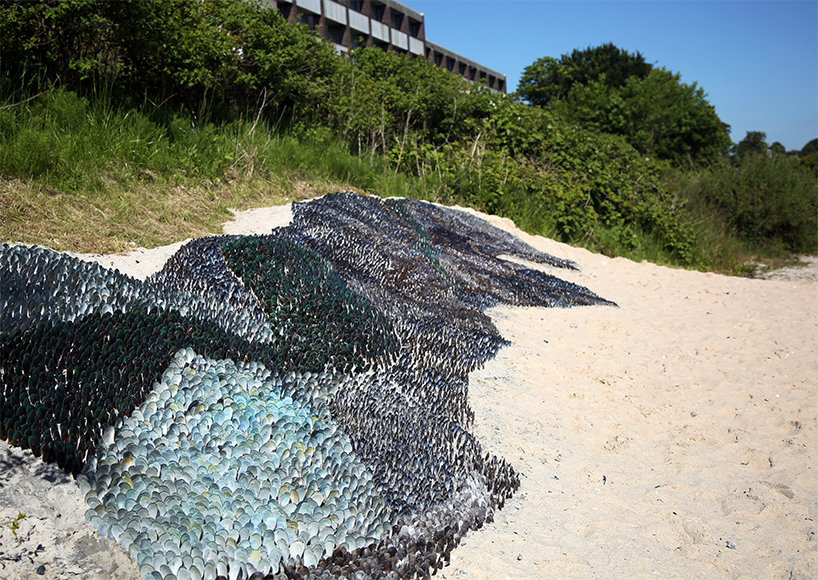

Installation view. Mussel shells. The ongoing ‘Indian Ocean Project’, by Subodh Kerkar. Aarhus, Denmark.
Let’s talk about the more unusual aspects of your particular creative journey. How did the world react when you made this switch from your medical career to art?
Everybody was against it. I had a successful medical practice, and pursuing art was limited to being only a hobby. However, my practice was a routine, I was tired of treating cough and cold, and tourist dysenteries. The idea of spending my lifetime doing just that was rather scary, I briefly considered going into medical research. Being the doctor for the Taj, they would lend me their Fort Aguada conference rooms ex-gratis, to exhibit my mostly realistic work in the form of landscapes and seascapes, couple of times in a year. I saw a way out of the routine of my medical career when people started buying. It was a clear affirmation that this was a viable path.
I gave my hospital to my brother to continue the practice, and I started a gallery, then went to Germany, and did illustrations for books. I was also a cartoonist for the local newspaper, doing political cartoons, I had a column in the Illustrated Weekly of India.

Installation view. Oceanic. Subodh Kerkar. The Himalayan Garden Sculpture Park. Yorkshire.
How did the world interact and react to your work?
I initially began showing watercolours and landscapes, in observation of seaside life. This was still palatable and acceptable to my medical fraternity and patients, but when I started conceptualising the large-scale installations, executed with with shells on the beach, I’m sure they were all confused and unsure of my mental state.
Fast forward to today: London School of Economics invited me to speak about Gandhi, because over the last six years, I have been studying the teachings of Gandhi very seriously, because I was infuriated with the state of the nation. So instead of just spewing a negative narrative of criticism and dissent, I started doing something pro-active. I’ve always connected with Gandhi, admired him from afar before this, but the political climate egged me to go deeper. I decided to get serious, collecting works related to Gandhi, and reading everything I could find.
I started doing a lot of work connected to his teachings, and saying that it had a huge impact on me, would be an understatement. It is very difficult to follow Gandhi’s philosophy in a country full of hatred. Hate is himsa, and this is what I have imbibed. One can oppose but not hate, polarisation of the country and spread of hate, is what catalysed my studies and research on the Mahatama’s teachings and life work.
As a further downstream effect of this, I’ve made and collected hundreds of works, encouraged and commissioned other artists to work on the same. And then finally, I do one or two talks every month in colleges and schools.
A moment of affirmation and fulfilment; I was invited as a speaker to Sevagram itself, on Gandhi Jayanti last year – the most fulfilling thing, speaking next to Gandhi’s hut, as his soul must’ve been watching.
Being a doctor by training has also lead me to conceptualise an innovative work of art based on an electric cardiogram of Gandhi. You see, any graph can be converted into sound. So, I have created a room in which, using an ECG machine, one can have an immersive experience, hearing Gandhi’s beating heart.
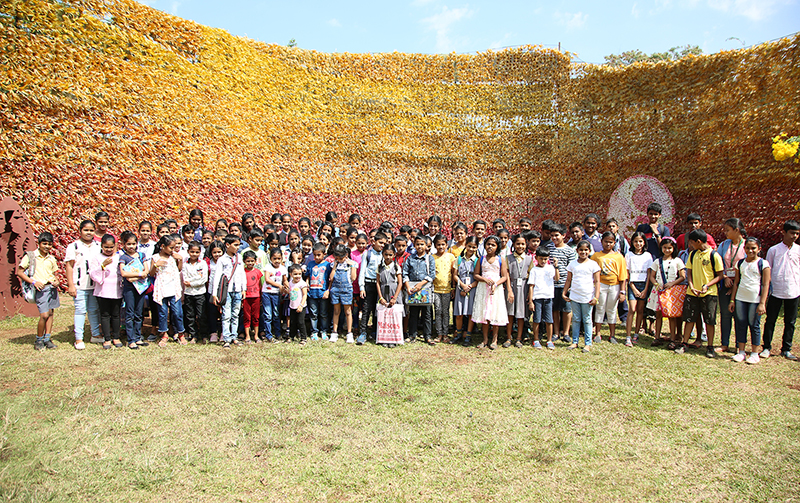
A group of young visitors at the Museum of Goa. Goa, India.
In a nutshell, it is my aim to be Tukaram of contemporary art, in the way which he could translate the complex Vedic philosophy, so it could be understood by the common man in simple language. Without him, the wisdom would not have translated to the masses, so in a way the Museum of Goa serves the same curatorial philosophy.
Subodh Kerkar
What are you looking for when you re-view artists work? Tell us about your curatorial philosophy.
The one main continuing theme in the museum is histories of Goa. And that doesn’t just mean Portuguese rule, it could even be what happened yesterday.
I’m keen to show work, which is created in response to local culture. Ninety percent of the visitors are first time museum visitors, locals and tourists alike. They carry a certain skepticism, and this continuing theme serves to connect the work on display with everybody. And that does not mean it’s low quality.
In a nutshell, it is my aim to be Tukaram of contemporary art, in the way which he could translate the complex Vedic philosophy, so it could be understood by the common man in simple language. Without him, the wisdom would not have translated to the masses, so in a way the MOG serves the same curatorial philosophy.
The word that comes to mind is access, and accessibility, basis which I choose works that speak to everybody. Work that speaks to everybody, which people wouldn’t forget. And of-course there should be a wow element, which can only happen if the works are sincere.
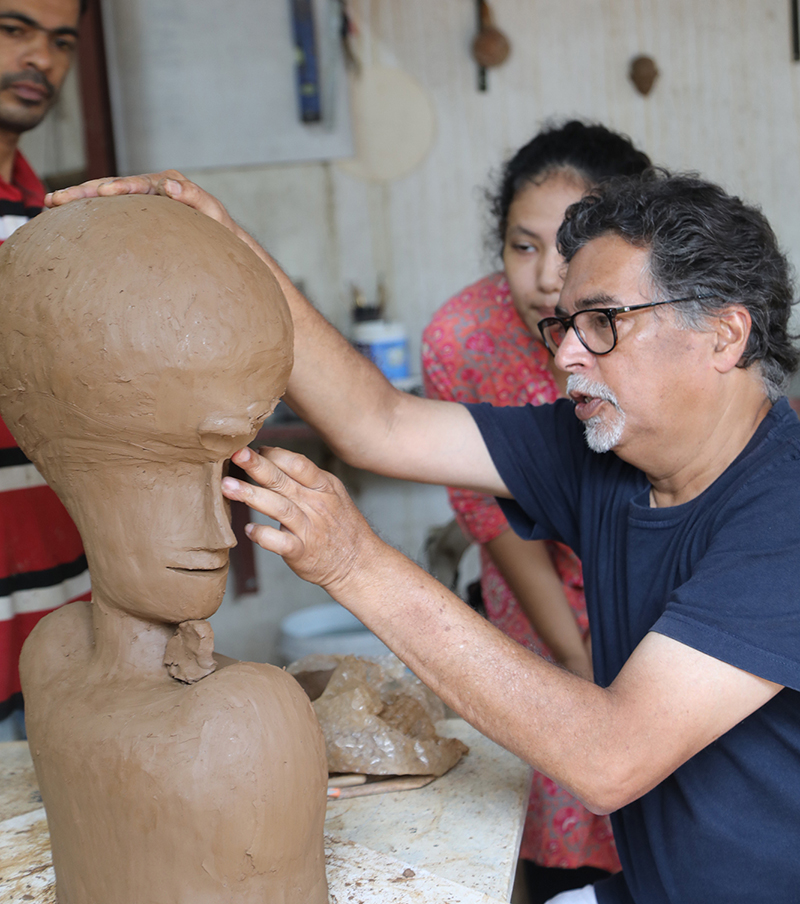
Studio view. Artist at work. Image courtesy Subodh Kerkar.
Tell us about your own work and its underlying themes.
My own work is heavily washed by the ocean and histories, I’m an ardent student of history via literature and poetry, being aware of what is happening around me, and all my study and awareness is expressed through my medium.
From the age of six to sixteen, I used to walk with my father on the beach everyday, and these walks shaped and developed a relationship between me and the ocean and me and my father.
So the ocean became a master and a muse, it plays a very personal role as it is inside and outside my work. I worked with fishermen, collecting old fishing canoes, and over the past three years, I’ve been working on a collaborative piece with the ocean itself; Subodh and the sea – wherein I submerge objects of historical value in the surrounding waters of Goa. Then, unexpected forms and textures are enacted upon them by the estuaries’ tidal action, and the inhabitants of these waters; the oysters and barnacles, resulting in a marriage of man and nature, in the form of un-replicable art.
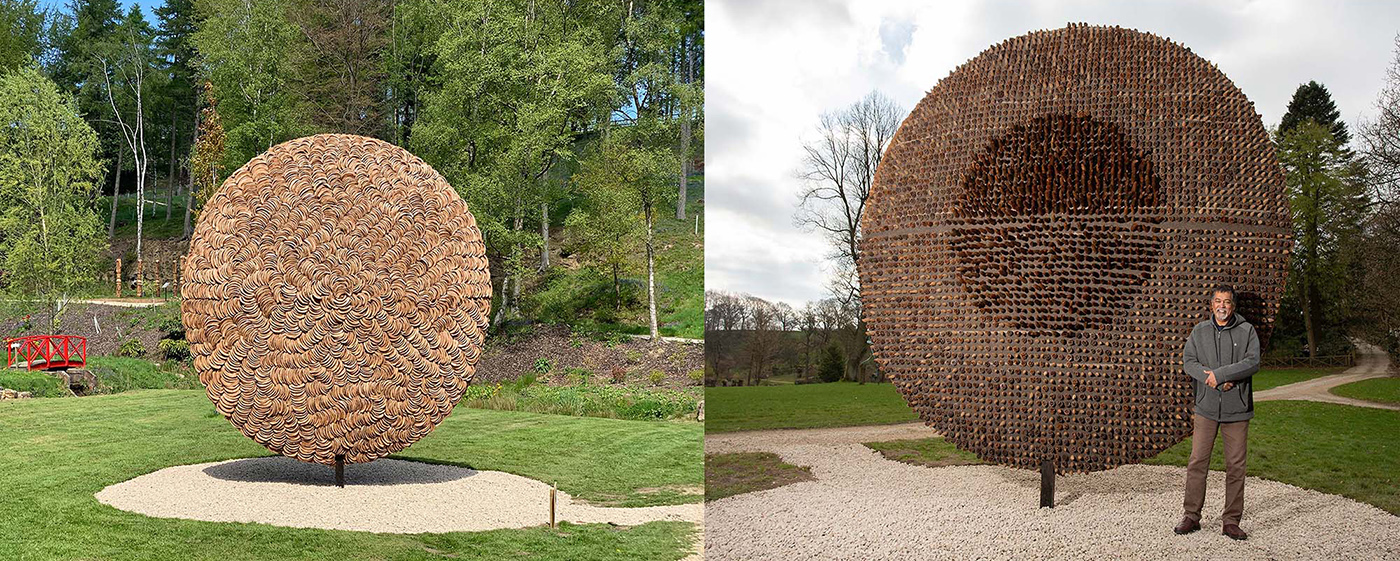
Installation view. The Pineapple Disc. (right) Subodh Kerkar. The Himalayan Garden Sculpture Park. Yorkshire.
What would you call you style?
I leave it open. Being medium agnostic gives me the freedom to experiment with styles. That said, the ocean is a consistent theme running through my work. When I say ocean, it encompasses history, as the ocean is a participant as well as medium of history. Considering any coastal culture as a sculpture, the ocean has been that historic sculptor. The ocean has facilitated dialogues between the coasts of continents, and that lead to historic changes in the world. Globalisation had already started in 1500 BC when Arab ships visited Lothal (Indus valley civilisation), one of the first ports of the world situated in the gulf of Khambatta in Gujrat, India.
The ocean was key in spreading theological teachings and philosophy. It contributed to the advance of the Harappan civilisation, as well as the very food we eat today. Chilies, Tomatoes, Peanuts and many other staples that have come to signify our culinary roots came to us from Brazil, via the ocean. The ocean is the source and platform for the current post-globalisation world as we see it today. And forever into the future. It is the maker, master and the muse. The ocean is a medium of culture and history.
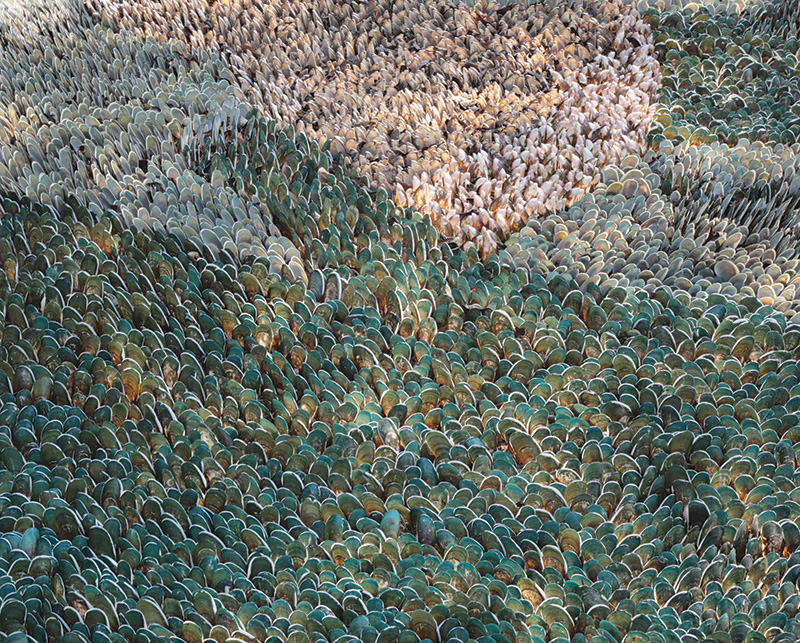
Detail view. Mussel shells. The ongoing ‘Indian Ocean Project’, by Subodh Kerkar. Aarhus, Denmark.
The ocean is the maker, master and the muse. The ocean is a medium of culture and history.
Subodh Kerkar
How does this translate commercially?
It is not possible to become a successful artist by calculating your yearly projected income. While I accept that an artist may need to support him or herself with commercial work, there is no place for that in real art. There is a real contradiction in this, and it has to be understood and pursued with honesty, so very few artists make a complete living with just art.
I have done this for 30 years, you need to be self critical, which will not happen if you are trying to fit your work to the demands of a market. Your work has to be absolutely sincere, and not market oriented.
An important factor for who I am today is that I have kept the child in me alive. Even now I have the same kind of wonderment and curiosity at the age of 60, I am a perpetual student of life.
The money I earn is a byproduct of my creative activity. Not the primary goal. Real art that you create should have nothing to do with the commercial aspect. That said, I admit that I’ve done all kinds of commercial work for hotels and receptions as is expected, one has to be clear, what are you doing it for. However if the primary goal is commercial, you become a slave of the market and then you stagnate. The market demands certain kind of work and then you will not dare deviate from that, and that could be the downfall.
The purpose of art is to make oneself happy, the process of creation is a reward in itself. Personally I feel the only purpose of life is to be happy, so if you do something you love, there is a possibility that you will be happy, and if you do something boring, you will be miserable. It is really as simple as that. I love what I do and it’s kept me absolutely joyful.

Exhibition view. The royal staff of the emperor of the ocean (left). From the ongoing series: Subodh and the sea. Subodh Kerkar. Museum of Goa, India.
Tell us about the clichés of making art in a tourist economy and the local art ecosystem and the local artists who deserve a special mention.
Having done watercolour seascapes myself, I felt the stagnation, and stopped doing them, years ago. Another cliché is the paintings of Goan windows, which has had its moment.
That said, real artists of Goa are not affected by the repetitive demand of tourist shoppers. Local artist group that deserve a special mention would be the Goa Artists Collective who did a brilliant show at MOG, put together by Pradeep Naik. There are many artists who deserve a special mention like Viraj Naik, Kedar Dhondu, Pramitesh Naik and Santosh Moriskar.
On the contrary, the influx of tourists results in sale. For example lot of people from Delhi and Mumbai, who have their second or third home in Goa, are my buyers.
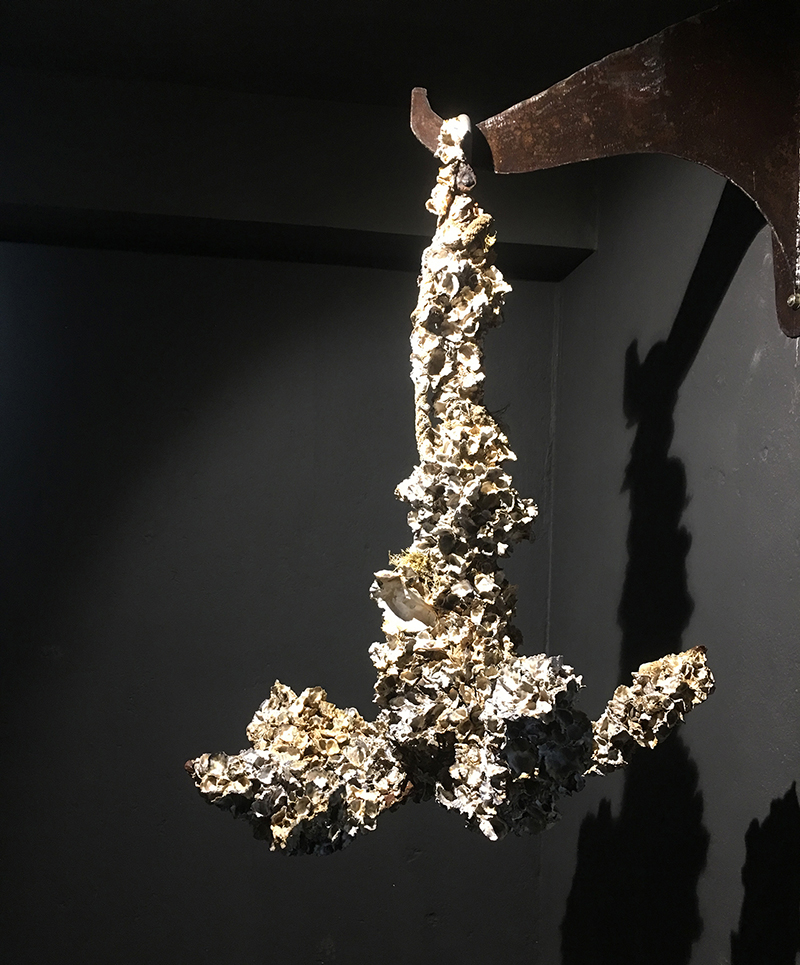
Exhibition view: Anchor. From the ongoing series: Subodh and the sea. Subodh Kerkar. Museum of Goa, India.
Please tell us the story of the birth of a museum in Goa. How did the Museum Of Goa come to be?
The Museum of Goa has absolutely no support of the government. It is a completely private, and self-funded enterprise. My father was a schoolteacher down the road from Pilerne (industrial area), and a new industrial estate was being set up adjacent to our village, so the secretary offered me a plot. I went across just to have a look, and found a lush piece of land overlooking a deep forested valley and fell in love with the space. The plot has been with me for last 25 years, it was my studio. This is why the museum is so unique, wherein it is nestled in an industrial estate, yet feels like one is in a forest.

Subodh Kerkar leads a hands-on creative workshop, at the Museum of Goa, India.
Let’s talk about your foray into education.
Education is definitely on the cards, as my son is going to the Chelsea School of Art in London. I’m taking on the financial burden because what option is there in India? Syllabi are outdated. It makes no sense having painting department and graphic department and applied art section, and sculpture department in art in today’s world. There is no mention of case studies or thinking out of the box.
Since the museum has been shut, I have been working on a series of lectures, conceiving a new way of teaching art. I’m thinking of starting a one year long residential course, where we won’t teach them how to paint or do sculpture, but present real case studies of contemporary artists, and their journeys. A course on how to think, connect with the arts and be more humane.
In fact, art should be the basis of teaching in all forms of education and liberal arts. So even if one is studying to be a doctor or engineer, you can become a better doctor, a better engineer. And you will become a better human being. Animals don’t make art, only humans have the urge to create. The creative ability to appreciate art is what differentiates us, and empowers us.
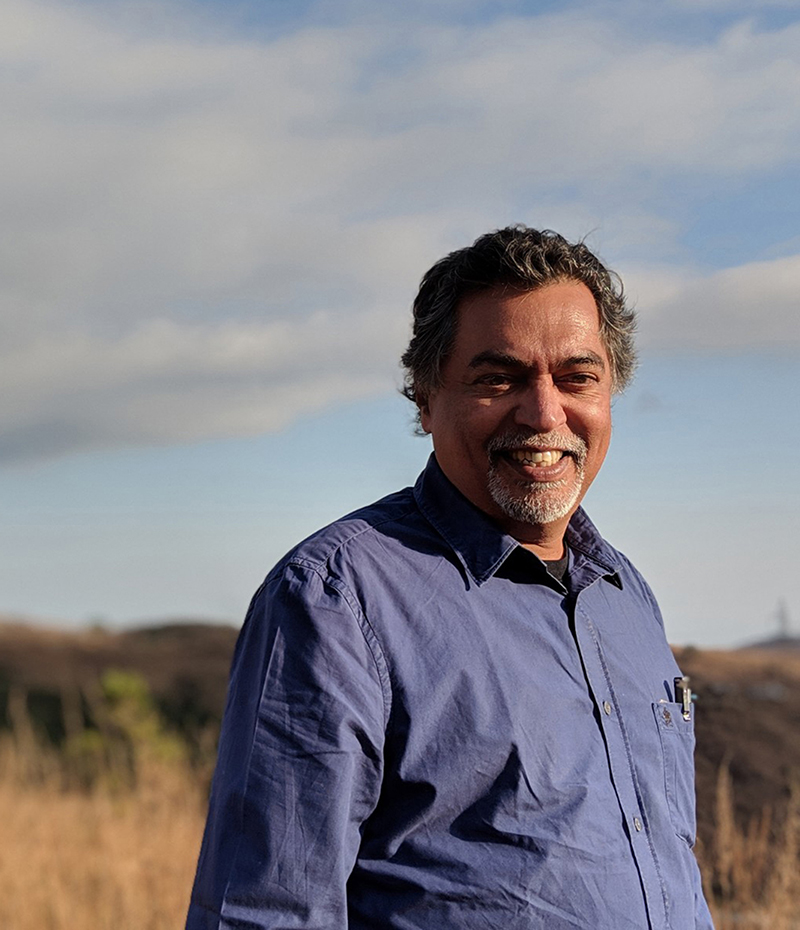
Portrait courtesy Subodh Kerkar.
Is there a recent anecdote or memory that reflects the ethos and values of Museum of Goa.
A few months ago, I had a dozen farmers visit the museum. I could make out from their traditional outfits, that they were not urban dwellers, but possibly from a rural agrarian background. They were speaking in Marathi (language spoken in neighbouring State of Maharashtra). I was fascinated and curious so I asked them – where are you from and how did you find out about this museum? Who recommended it to you? Turns out they had made their way all the way from Sindhudurg, Malvan area, in Maharasthra, about hundred plus kilometers north of Goa on the coast.
They told me – One of our farmer friend’s brother visited Goa and saw your museum, and liked it so much, that he came back and told us that when you go to Goa, don’t waste your time going to see the beaches. The Goan ocean is exactly like ours, but you absolutely must go see the Museum of Goa.
The purpose of my museum is to take art to the common people. If a farmer can connect with contemporary art, that is my success. No financial milestone will ever match this compliment to Museum of Goa, from the common man.
Subodh Kerkar
Hence they had made the trip across, in a big group of a dozen or so individuals, and this incident has been one of the most affirming and fulfilling recent memories for me.
The purpose of my museum is to take art to the common people. If a farmer can connect with contemporary art, that is my success. No financial milestone will ever match this compliment to MOG, from the common man. These are the very people who are excluded from the high-flying dialogues of art in white box galleries, and they are seeking to experience contemporary art thanks to the way we have presented it at MOG.
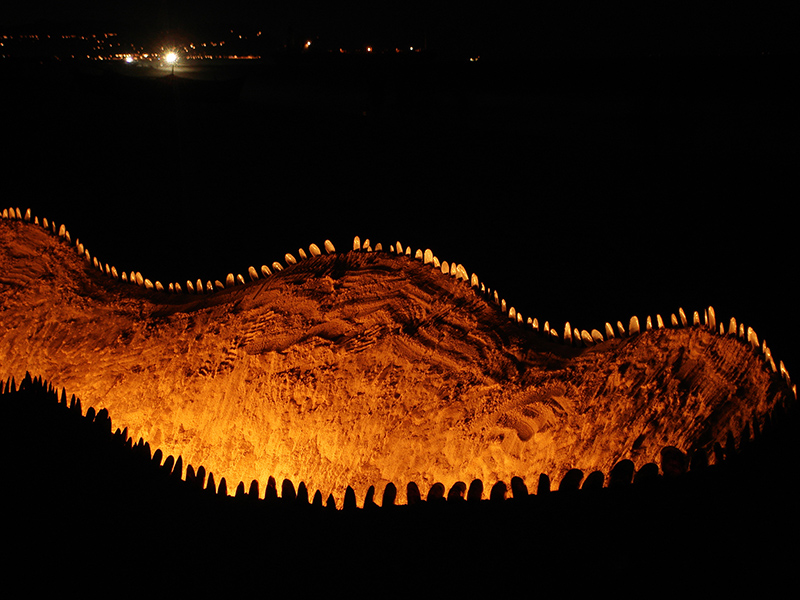
Installation view. The Sea Anemone. Subodh Kerkar. Goa, India.
What can we look forward to? What is coming next?
I have been working on a series of children books, which has been a long-standing dream. These started as stories I came up with for my own children when they were growing-up, now being embellished and illustrated, as art is the universal language for kids worldwide. I’m going to complete a set of ten, and market them world-wide, six of these are already complete with designs and layouts.
I am also teaching online, mentoring students. It is quite strange that a doctor is conducting art courses, as the Mario Miranda Chair at the University (of Goa), in an interesting twist of fate and serendipity.
Before you go – you might like to browse the Asian Curator curatorial archives . Contemporary art curators and international gallerists define their curatorial policies and share stories and insights about the inner runnings of the contemporary art world.








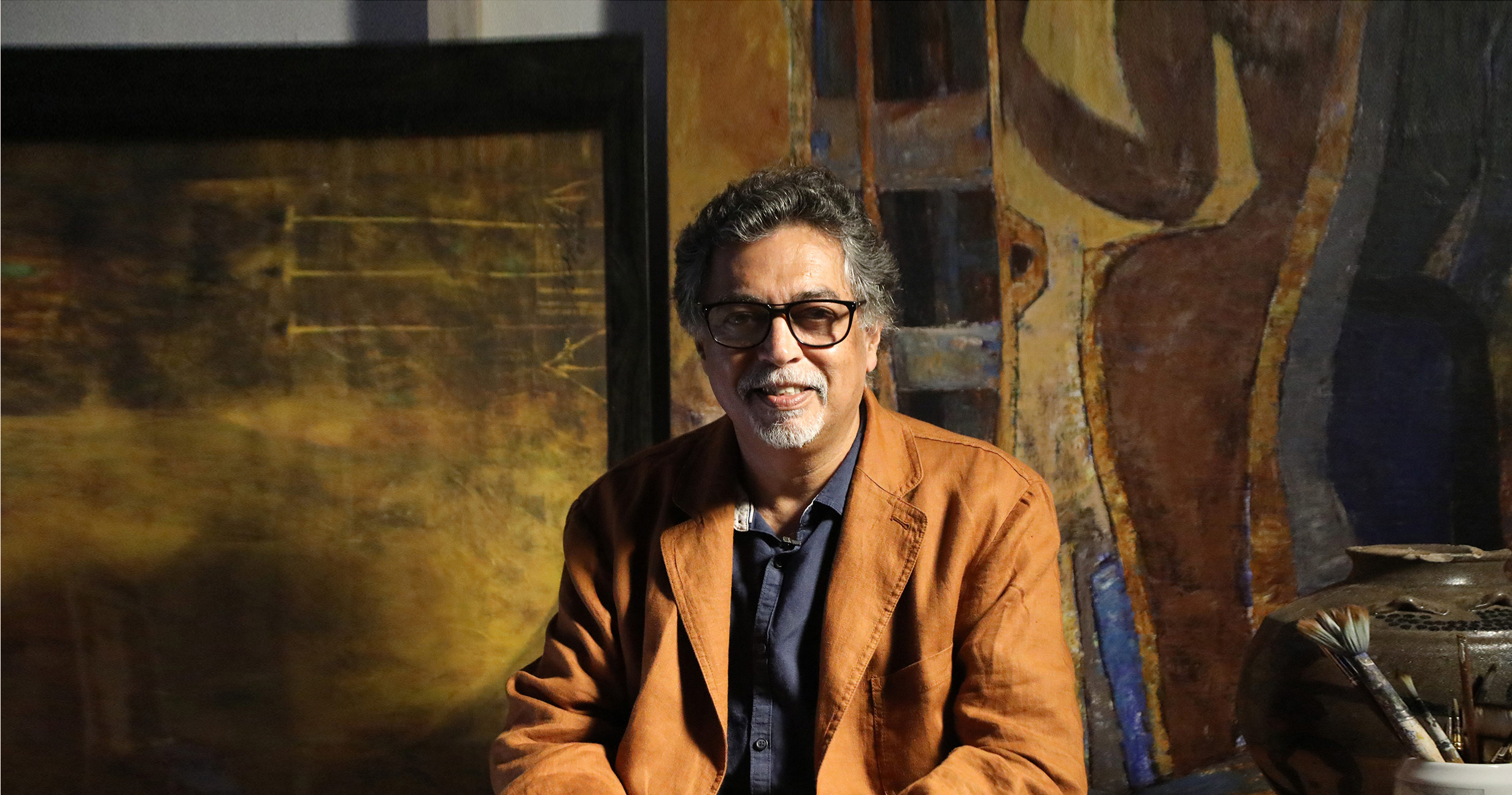



Add Comment